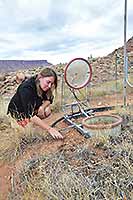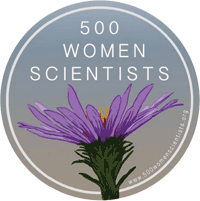Women scientists have helped shape our understanding of the science of the Colorado Plateau making lasting contributions to numerous fields of science, technology, engineering, and mathematics. This work has had wide reaching impacts, ranging from cataloging plant life in the Grand Canyon to helping Colorado fight against polio and tuberculosis. Women scientists working on the Colorado Plateau continue to be trailblazers for others to follow. While the list of influential women scientists working on the Colorado Plateau is impressive, the following is a select list of four women whose work continues to be impactful in the Moab area and beyond.
.jpg) |
| Elzada Clover and Grand Canyon naturalist Eddie McKee. Grand Canyon National Park photo |
Dr. Elzada Clover (1897–1980) was an American botanist who was the first to catalog plant life on the Colorado River. Clover and graduate student Lois Jotter became the first women to complete a river run of the Grand Canyon starting at Green River, Utah through the Cataract Canyon rapids and on to Lake Mead. Their run took 43 days in three custom built boats. Dr. Clover and Jotter’s comprehensive botanical survey remains the only one on the Colorado River’s riparian species in the era before Glen Canyon Dam was built.
Alice Hunt (1906-2002) was an American archaeologist in the Anthropology Department at the University of Utah. Hunt earned a bachelor’s degree in economics from Vassar College in New York in 1928 and a master’s degree in anthropology from the University of Denver in 1952. Hunt and her husband completed highly detailed anthropological and archaeological surveys in the Henry Mountains and the La Sal Mountains, among other remote areas of the west. Her work in the La Sal’s, which spanned between 1949 and 1952, documented 350 archaeological sites and the results were published with Gottfried O Lang in The Archaeological survey of the La Sal Mountain Area, Utah (1953).
 Dr. Jayne Belnap is a research ecologist with the biological division of the USGS in Moab. Dr. Belnap has focused on dryland and rangeland ecosystems with a particular emphasis on the role of biological soil crusts (moss, lichen, cyanobacteria, and fungi) in dryland ecosystems including soil stability, nutrient cycling, and hydrological cycles. In 2008, Dr. Belnap was recognized by the Ecological Society of America as one of the most outstanding ecologists in the United States and in 2010 and 2013, she received awards as one of the outstanding women in science from the US Department of Interior. Dr. Jayne Belnap is a research ecologist with the biological division of the USGS in Moab. Dr. Belnap has focused on dryland and rangeland ecosystems with a particular emphasis on the role of biological soil crusts (moss, lichen, cyanobacteria, and fungi) in dryland ecosystems including soil stability, nutrient cycling, and hydrological cycles. In 2008, Dr. Belnap was recognized by the Ecological Society of America as one of the most outstanding ecologists in the United States and in 2010 and 2013, she received awards as one of the outstanding women in science from the US Department of Interior.
Dr. Sasha Reed is also a research ecologist with the biological division of the USGS in Moab. Dr. Reed has a Ph.D. in biogeochemistry from the University of Colorado at Boulder. Dr. Reed’s research focuses on understanding how drought and increasing temperatures affect ecosystems, exploring a diversity of energy options for meeting national demand, assessing the consequences of exotic plant invasion and ways to combat them, and establishing novel management options for increased effectiveness and efficiency in restoration. In 2016, Dr. Reed was awarded an Early Career Fellowship by the Ecological Society of America, and in 2011, she was awarded the Presidential Early Career Award for Scientists and Engineers (PECASE).
 Southeast Utah 500 Women Scientists
Mission and Values: Southeast Utah 500 Women Scientists
Mission and Values:
Our Mission:
• To share the importance of science.
• To support one another as a community of women scientists in Southeast Utah
• To be in service in the name of science to the communities of Southeast Utah.
Our Values
Being a supportive group for women scientists in Southeast Utah
Advocate for inclusivity in our group and in science at large
Increase scientific literacy for locals and tourists
Mentor and support students of science (especially girls) |
|